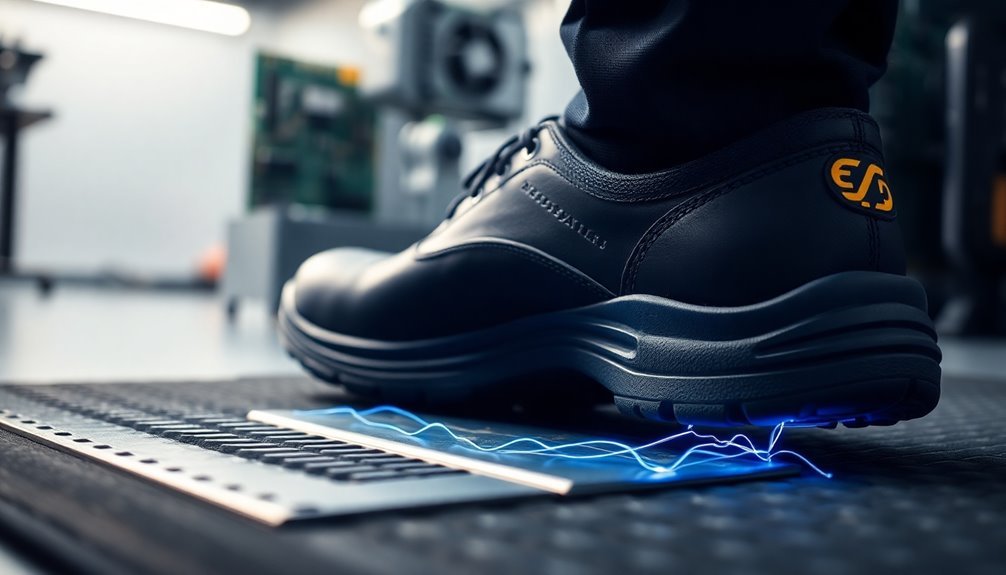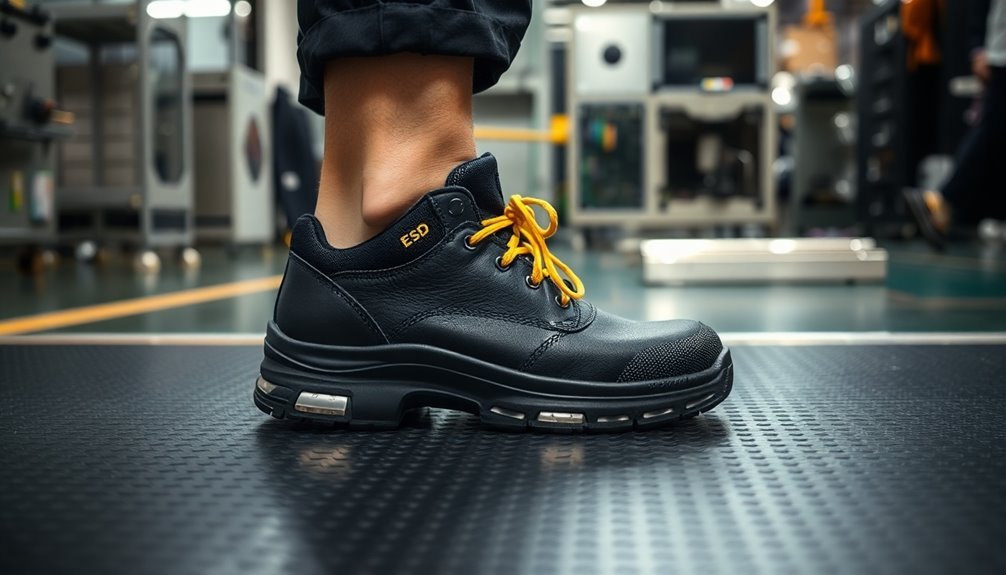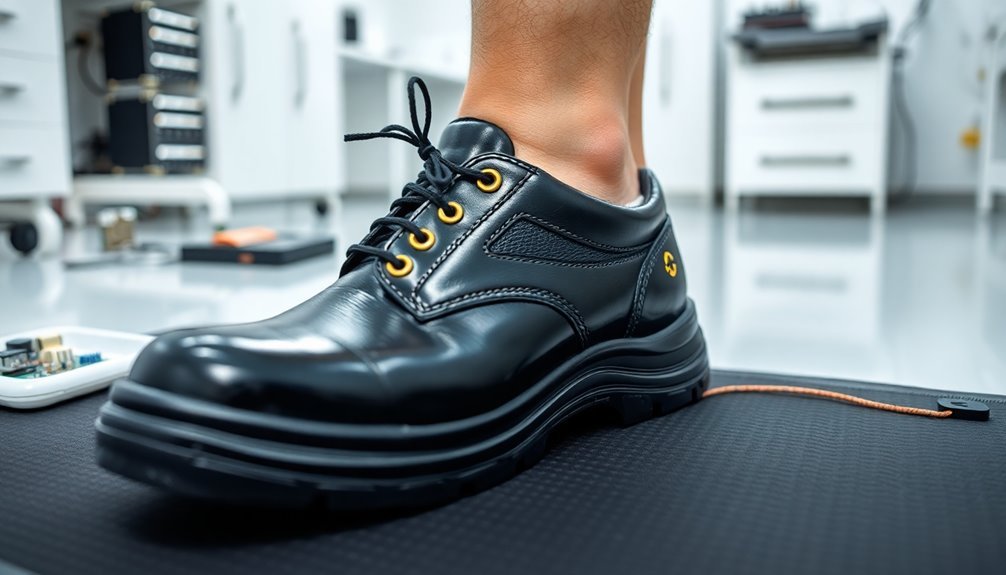Electronics technicians need ESD safety shoes because static electricity can destroy sensitive electronic components. When you walk around, your body can generate thousands of volts of static charge, especially in low-humidity environments or when wearing synthetic materials. ESD safety shoes help dissipate this static safely to the ground, preventing sudden discharges that could damage expensive equipment or critical components. Your shoes must maintain electrical resistance below 1.0 x 10^9 Ω to effectively protect against static buildup. Understanding proper ESD footwear standards, types, and maintenance will help you maximize workplace safety and protect valuable electronic equipment.
Understanding ESD Safety Fundamentals

Working with sensitive electronic components demands a thorough understanding of electrostatic discharge (ESD) fundamentals. As an electronics technician, you'll encounter static electricity that can transfer between objects, potentially causing catastrophic failures or latent defects in the components you're handling. Industry data shows that ESD-related failures cost billions annually in electronics manufacturing. ESD events can occur in microseconds, making prevention vital to your work.
You'll need to understand that proper grounding is the cornerstone of ESD control. Using anti-static wrist straps helps safely discharge static from your body while working. When you're working in an ESD-protected area, you're operating in a space specifically designed to minimize static risks through anti-static flooring, controlled temperature, and humidity levels. These controls work together to prevent static buildup and protect sensitive components.
Your role in maintaining ESD safety extends beyond just wearing protective equipment. You'll need to regularly verify the effectiveness of your grounding devices and understand how environmental factors affect static buildup.
Regular testing at ESD stations guarantees you're properly grounded, while maintaining awareness of your workspace's ventilation and humidity levels helps reduce static risks. This all-encompassing approach to ESD safety protects both the components you're working with and the quality of your output.
Static Discharge Risk Assessment
Electronics technicians' understanding of static discharge risks forms the foundation of effective ESD control. When you're working with sensitive electronic components, you'll face multiple static generation sources that can damage equipment and compromise safety. The risk increases considerably in low humidity environments and when you're wearing synthetic materials like wool or polyester. Proper ESD secured areas should be established to maintain comprehensive protection against static discharge. Regular audits and inspections help ensure that ongoing compliance with safety standards is maintained.
| Risk Factor | Impact |
|---|---|
| Friction & Movement | Can generate up to thousands of volts |
| Low Humidity | Increases static buildup potential |
| Synthetic Materials | Creates continuous discharge risk |
You're not just protecting equipment; you're preventing substantial economic losses. Static discharge can cause irreversible damage to components, leading to product failure and expensive replacements. That's why proper ESD footwear is essential in your daily work routine.
When selecting ESD safety shoes, you'll need to verify they meet specific standards. Look for footwear with electrical resistance less than 1.0 x 10^9 Ω and clear ESD markings. Your shoes should effectively conduct static charges to the ground while providing comfort during long work hours. Remember, different work environments may have varying ESD requirements, so choose footwear that matches your specific workplace needs.
ESD Footwear Performance Standards

You'll need to understand that ESD footwear must maintain resistance levels below 1.0 x 10^9 Ω to effectively dissipate static charges according to EN 61340 standards.
Your ESD safety shoes require proper certification through standardized testing methods that verify both the electrical conductivity and static dissipation capabilities of the materials used.
The footwear's materials must meet specific certification guidelines, including being non-static generating and moisture-permeable, to guarantee consistent performance in protecting sensitive electronic components. Regular cleaning and maintenance helps preserve the shoes' conductivity levels for optimal static control performance. Compliance with ASTM F2413 standards is mandatory to ensure comprehensive safety protection in electronics manufacturing environments.
Testing and Resistance Requirements
When it comes to ESD safety footwear, meeting strict testing and resistance requirements is essential for protecting sensitive electronic components.
You'll need to guarantee your safety shoes comply with established standards like EN 61340 and ANSI/ESD S20.20-2007, which specify the maximum electrical resistance allowed between you and the ground.
The testing process verifies that your ESD footwear can effectively dissipate static charges while maintaining consistent electrical conductivity. Proper static charge dissipation helps prevent damage in electronics manufacturing environments.
Your shoes must work in conjunction with ESD-safe flooring to create a complete ground path, with the total system resistance staying below 1.0 x 10^9 Ω.
- Electrical resistance measurements must be performed regularly to guarantee ongoing compliance with safety standards.
- Testing should verify the footwear's ability to consistently conduct electricity from your body to the ground.
- Performance testing must confirm that the shoes can prevent static electricity buildup while protecting both you and sensitive electronics.
Material Certification Guidelines
Building on proper resistance testing, understanding material certification guidelines guarantees your ESD footwear meets rigorous performance standards. Your ESD shoes must comply with EN 61340 specifications and maintain electrical resistance below 1.0 x 10^9 Ω to guarantee proper static discharge protection.
When selecting ESD footwear, you'll need to verify it's manufactured with specialized conductive materials that meet ANSI/ESD S20.20-2007 standards. The shoes should feature soft but durable leather construction and non-PVC materials that provide both comfort and reliable static protection. Look for the ESD marking that confirms compliance with required standards.
Your workplace requirements will dictate specific certifications needed. If you're working in electronics manufacturing or cleanroom environments, your footwear must meet stringent ASTM standards and industry-specific regulations.
For aerospace or medical device manufacturing, additional certifications may apply.
You'll need to maintain proper documentation of your ESD footwear's certification and participate in regular inspections to guarantee continued compliance. Remember that recognized certification bodies must verify all ESD footwear, and you should receive training on proper use and maintenance to maintain its protective properties.
Workplace Protection Requirements
Modern workplaces handling sensitive electronic components demand strict ESD protection measures, including specialized safety footwear.
As an electronics technician, you'll need to comply with specific requirements that protect both you and the sensitive equipment you work with. These requirements are particularly stringent in electronics manufacturing, cleanrooms, and data centers where static electricity can cause irreversible damage.
Your workplace protection requirements must align with international standards like EN 61340, especially when you're working in environments where ESD safety is critical.
You'll need to guarantee your safety shoes work in conjunction with other ESD protection equipment, including wrist straps, mats, and specialized garments.
Key workplace requirements include:
- Wearing ESD-marked safety shoes that provide the correct level of static control for your specific work environment
- Regular maintenance and cleaning of your ESD footwear to maintain its protective properties
- Compliance verification through routine testing to guarantee your shoes meet industry-specific standards
Common ESD Footwear Types

To meet workplace protection requirements effectively, you'll need to select the right type of ESD footwear for your specific environment.
You'll find three main categories of ESD footwear available: safety shoes, standard ESD shoes, and ESD sandals.
ESD safety shoes offer the most thorough protection, combining both static control and physical safety features. They're ideal if you work in environments where foot protection is essential, such as manufacturing facilities.
These shoes comply with industry standards like EN 61340 and feature conductive materials that safely dissipate static charges.
Standard ESD shoes focus primarily on static discharge prevention and come in various styles, including trainers and slip-ons.
You'll find these comfortable for all-day wear, making them perfect for assembly lines and general electronics work.
If you're working in a cleanroom or environment where ventilation is important, ESD sandals provide a breathable alternative while maintaining vital static protection.
All ESD footwear must have an electrical resistance below 1.0 x 10^9 Ω and display proper ESD marking.
You'll want to verify your chosen footwear meets these specifications and includes features like proper cushioning and support for extended wear.
Maintaining Your ESD Safety Shoes
Proper maintenance of your ESD safety shoes is vital for guaranteeing consistent static protection and prolonging their lifespan. You'll need to clean them regularly using mild soap and water, avoiding harsh chemicals that could damage the conductive materials. The shoes' ability to dissipate static electricity makes them essential for protecting sensitive electronics during maintenance work.
After cleaning, let them air dry naturally, as heat can compromise their protective properties.
Regular inspection and testing are important to maintain peak performance. Check your shoes for visible wear, cracks, or damage, particularly on the soles where conductivity is critical. You should test the electrical resistance regularly using appropriate equipment and keep detailed records of all inspections.
- Store your ESD shoes properly when not in use:
- Keep them in a dry, clean area away from direct sunlight
- Use original packaging or protective bags
- Avoid stacking or compressing them
Don't wait until your shoes completely fail before replacing them. If they show significant wear or no longer meet resistance standards, it's time for a new pair.
Always document your replacement process and dispose of old shoes according to manufacturer guidelines to prevent unauthorized use. Proper maintenance not only guarantees your safety but also maximizes your investment in ESD protection.
Frequently Asked Questions
Can ESD Safety Shoes Be Worn Outside the Work Environment?
You can wear ESD safety shoes outside work, but it's not recommended. They'll wear down faster, won't function properly on regular surfaces, and you'll reduce their effectiveness when you need them at work.
How Often Should ESD Safety Shoes Be Replaced?
You should replace your ESD safety shoes every 6-12 months, or sooner if you notice visible wear, reduced conductivity, or failed ESD tests. Don't wait until they're completely worn out for replacement.
Do ESD Safety Shoes Protect Against Water and Chemical Splashes?
No, your ESD safety shoes won't protect against water or chemical splashes. They're specifically designed to dissipate static electricity. You'll need separate protective footwear for water and chemical protection in hazardous environments.
What Happens if Regular Shoes Are Worn Instead of ESD Footwear?
If you wear regular shoes, you'll risk damaging sensitive electronics through static discharge, face potential safety hazards, violate workplace standards, and could cause costly equipment failures or even trigger dangerous static-related accidents.
Can ESD Safety Shoes Lose Their Protective Properties in Extreme Temperatures?
Yes, your ESD safety shoes can lose their protective properties in extreme temperatures. High heat may degrade materials and affect conductivity, while cold can increase electrical resistance, reducing their ability to dissipate static charges effectively.
In Summary
You'll need ESD safety shoes as an essential part of your electronics technician safety gear to prevent static discharge that could damage sensitive components. They'll keep you grounded while working, protecting both you and valuable equipment. Remember to maintain your ESD footwear properly, test them regularly, and replace them when worn out. Don't compromise on safety standards – your ESD shoes are vital for workplace protection.





Leave a Reply